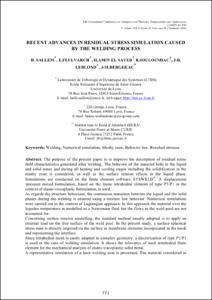Mostra el registre d'ítem simple
Recent advances in residual stress simulation caused by the welding process
| dc.contributor.author | Sallem, H. |
| dc.contributor.author | Feulvarch, E. |
| dc.contributor.author | Sayed, H. Amin El |
| dc.contributor.author | Souloumiac, B. |
| dc.contributor.author | Leblond, J-B. |
| dc.contributor.author | Bergheau, J-M. |
| dc.date.accessioned | 2015-11-12T19:06:38Z |
| dc.date.available | 2015-11-12T19:06:38Z |
| dc.date.issued | 2015 |
| dc.identifier.citation | Sallem, H. [et al.]. Recent advances in residual stress simulation caused by the welding process. A: COMPLAS XIII. "COMPLAS XIII : proceedings of the XIII International Conference on Computational Plasticity : fundamentals and applications". CIMNE ed. Barcelona: CIMNE, 2015, p. 771-782. |
| dc.identifier.isbn | 978-84-944244-6-5 |
| dc.identifier.uri | http://hdl.handle.net/2117/79195 |
| dc.description.abstract | The purpose of the present paper is to improve the description of residual stress field characteristics generated after welding. The behavior of the material both in the liquidand solid states and during all heating and cooling stages including the solidification in the mushy zone is considered, as well as the surface tension effects in the liquid phase.Simulations are conducted on the finite element software SYSWELD®. A displacement/pressure mixed formulation, based on the linear tetrahedral element of type P1/P1 in the context of elasto-viscoplastic formulation, is used. As regards the structure behaviour,thecontinuous transition between the liquid and the solid phases during the welding is ensured using a mixture law behavior. Numerical simulations were carried out in the context of Lagrangian approach. In this approach the material over the liquidus temperature is modelled as a Newtonian fluid but the flows in the weld pool are not accounted for.Concerning surface tension modelling,the standard method usually adoptedis to apply an externalloadon the freesurface of the weld pool. In the present study, a surfacespherical stress state is directly imposed on the surface in membrane elements incorporated in the meshand representing the interface.Since tetrahedral mesh is easily adapted to complex geometry, a discretization of type P1/P1 is used in the case of welding simulation. It shows the relevance of such tetrahedral finite element for the mechanical analysis of elasto-viscoplastic solid metal.A representative simulation of a laser welding case is processed. The material considered in H. Sallem, E.Feulvarch, H.Amin El Sayed, B.Souloumiac, J-B Leblond, J-M Bergheau this study is the Inconel 600 alloy. Computed residual stress distribution revealsthe ability of such approaches topredictresidual stress states in assessing the integrity of welded components. |
| dc.format.extent | 12 p. |
| dc.language.iso | eng |
| dc.publisher | CIMNE |
| dc.subject | Àrees temàtiques de la UPC::Matemàtiques i estadística::Anàlisi numèrica::Mètodes en elements finits |
| dc.subject | Àrees temàtiques de la UPC::Enginyeria civil::Materials i estructures::Materials i estructures metàl·liques |
| dc.subject.lcsh | Finite element method |
| dc.subject.lcsh | Plasticity -- Mathematical models |
| dc.subject.lcsh | Plasticity |
| dc.subject.lcsh | Welding--Mathematical models |
| dc.subject.other | Welding |
| dc.subject.other | Numerical simulation |
| dc.subject.other | Mushy zone |
| dc.subject.other | Behavior law |
| dc.subject.other | Residual stresses |
| dc.title | Recent advances in residual stress simulation caused by the welding process |
| dc.type | Conference lecture |
| dc.subject.lemac | Elements finits, Mètode dels |
| dc.subject.lemac | Plasticitat -- Models matemàtics |
| dc.subject.lemac | Plasticitat |
| dc.subject.lemac | Soldadura -- Mètodes numèrics |
| dc.rights.access | Open Access |
| local.citation.contributor | COMPLAS XIII |
| local.citation.pubplace | Barcelona |
| local.citation.publicationName | COMPLAS XIII : proceedings of the XIII International Conference on Computational Plasticity : fundamentals and applications |
| local.citation.startingPage | 771 |
| local.citation.endingPage | 782 |
| local.citation.edition | CIMNE |


